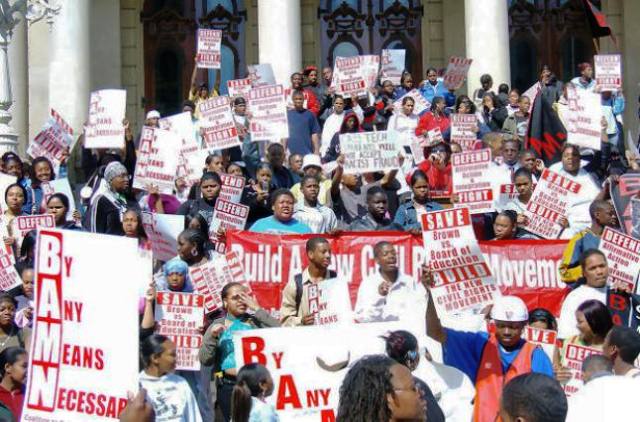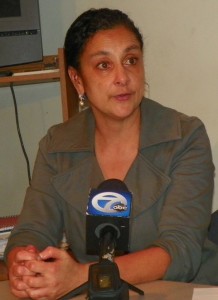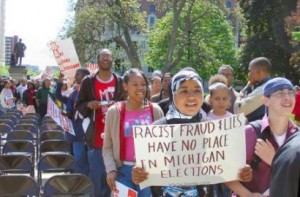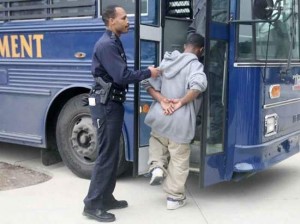- State students begin campaign to double minority enrollment now
- Plaintiffs say they welcome state AG’s appeal to U.S. Supreme Court
- Case connected to others from Texas, California
By Diane Bukowski
November 18, 2012
DETROIT – In a historic ruling Nov. 15, the U.S. Court of Appeals for the Sixth Circuit overturned Michigan’s anti-affirmative action ban, passed by state voters in 2006 as Proposal 2. By a close vote of 8-7, the full Sixth Circuit thereby rejected Michigan Attorney General Bill Schuette’s appeal of the Court’s finding on July 1, 2011 that the ban violates the 14th “equal protection” Amendment to the U.S. Constitution.
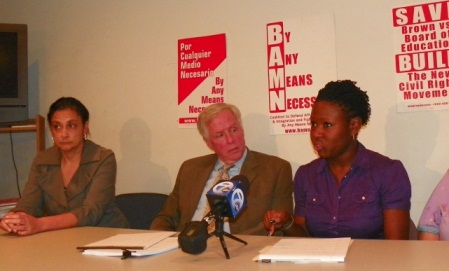
ttorneys Shanta Driver. George Washington and Monica Smith announce affirmative action victory Nov. 15, 2012.
“Finally the University of Michigan, Michigan State and Wayne State Universities, along with colleges across the state, will be able to re-open their doors to Black and Latino students,” said attorney Shanta Driver during a press conference Nov. 15 in downtown Detroit. She and attorney George Washington argued the case on behalf of the lead plaintiff, the national Coalition to Defend Affirmative Action, Integration, & Immigrant Rights and Fight for Equality (BAMN).
“This is a huge victory for BAMN and the new civil rights movement,” Driver explained. “It reflects the slow leftward direction most of the country wants to take. It brings an end to an era of using ballot proposals in a cynical way, at the expense of Black and Latino youth, and should convince opponents of affirmative action nationally that they cannot use ballot fraud and win.”
Michigan voters passed Prop. 2, a state constitutional amendment, in Nov. 2006. It struck down all programs in public educational institutions granting “preferential treatment . . . to any individual or group on the basis of race, sex, color, ethnicity or national origin.”
That included not only students, but workers and businesses contracting with the institutions. Nine out of ten Black voters voted against Proposal 2, but it passed by 58 percent because white voters supported it two to one.
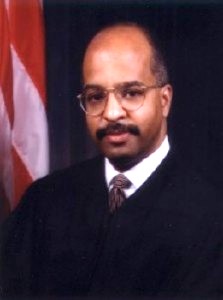
Justice Ransey Guy Cole, Jr. of the U.S. Sixth Circuit Court of Appeals wrote the court’s majority decision.
Washington noted that since then, the U.S. is becoming a “majority-minority” country.
“The decision means universities will be able to open their doors to the newly-emerging majority across the U.S,” he said.
In its closely divided ruling, U.S. Sixth Circuit Court Justice Ransey Guy Cole, Jr. explained in basic terms the reason for the court’s ruling.
“A student seeking to have her family’s alumni connections considered in her application to one of Michigan’s esteemed public universities could do one of four things to have the school adopt a legacy-conscious admissions policy. She could lobby the admissions committee, she could petition the leadership of the university, she could seek to influence the school’s governing board, or, as a measure of last resort, she could initiate a state-wide campaign to alter the state’s constitution.”
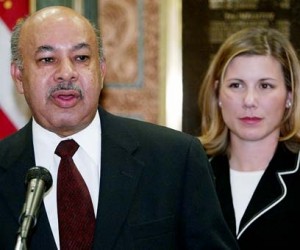
Ward Conerly and Jennifer Gratz, initiators of MCRI. Conerly also helped sponsor California Proposition 209.
The last is what white student Jennifer Gratz resorted to, supported by California businessman Ward Conerly and funded by corporate right-wing think tanks.
Justice Cole continued, “The same cannot be said for a Black student seeking the adoption of a constitutionally-permissible race-conscious admissions policy. That student could do only one thing to effect change: she could attempt to amend the Michigan Constitution—a lengthy, expensive, and arduous process—to repeal the consequences of Proposal 2. The existence of such a comparative structural burden undermines the Equal Protection Clause’s guarantee that all citizens must have equal access to the tools of political change. We therefore REVERSE the judgment of the district court on this issue and find Proposal 2 unconstitutional.” (Read full decision at http://www.ca6.uscourts.gov/opinions.pdf/12a0386p-06.pdf.)
Cole wrote in the Court’s July 1 panel decision that two previous Supreme Court decisions, Seattle, 458 U.S. at 467, and Hunter, 393 U.S. at 393, clarify that equal protection of the law is also “an assurance that the majority may not manipulate the channels of change in a manner that places unique burdens on issues of importance to racial minorities . . . . an electoral minority is by definition disadvantaged in its attempts to pass legislation.”
Schuette said he plans to appeal the en banc ruling on what he called “The Michigan Civil Rights Initiative” (MCRI), the name of the group that campaigned to put Proposal 2 on the Michigan ballot. Its petition-takers frequently told signers they were signing to support a pro-civil rights amendment.
“MCRI embodies the fundamental premise of what America is all about: equal opportunity under the law,” he said in a release. “Entrance to our great universities must be based upon merit. We are prepared to take the fight for equality, fairness and the rule of law to the U.S. Supreme Court.”
Driver, Washington and attorney Monica Smith of BAMN said they welcome that opportunity. They said it will aid the building of a national movement in conjunction with other states. A decision from the U.S. high court is pending on oral arguments held Oct. 10 in Fisher v. Texas, and an appeal of a Ninth Circuit Court of Appeals decision supporting California’s Proposition 209, is also pending before the USSC.
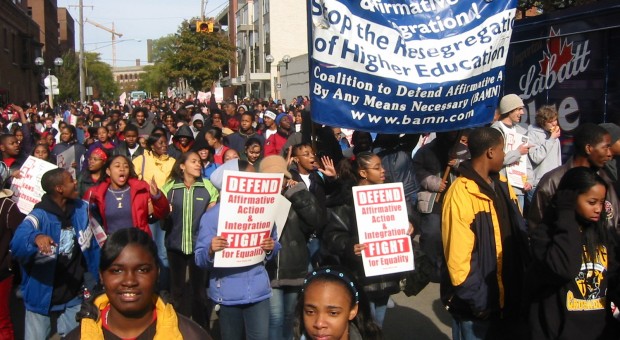
March to support affirmative action on Dr. Martin Luther King, Jr. Day, 2003, prior to USSC decision.
Attorney Monica Smith said she, along with her brother and cousin, graduated from Michigan universities only because of their affirmative action policies. U of M’s policies were upheld by the U.S. Supreme Court in 2003 in Grutter v. Bollinger. BAMN and other groups brought 50,000 people, including many Michigan students, to the steps of the USSC in Washington, D.C. that year.

Monica Smith (right) and other protesters confront Jennifer Gratz as she enters U.S. District Court in downtown Detroit to defend Proposal 2.
“I joined BAMN for this reason, to win affirmative action,” she said. “I was in the very last class of law students at Wayne State before Proposal 2 took effect. In my class, only 22 out of 300 students were Black. The following year, that number diminished to 11. This fight is our generation’s Brown v. the Board of Education.”
Smith said that the small number of Black and Latin students in her class, even before Proposal 2, contributed many times to a hostile atmosphere based on race, in the middle of a city that is at least 82 percent Black. She said the following year’s drop in ‘minority’ enrollments also hurt white and poor students, because the size of the entire class diminished overall due to funding cutbacks.
In previous years, even at the undergraduate level, the majority of students at WSU have been white, at one point comprising 83 percent of the student population. Meanwhile many Black students in Detroit and other cities across the state are denied admission and funneled into what the Michigan chapter of the American Civil Liberties Union termed “The School to Prison Pipeline” in a 2009 study, available at http://www.aclumich.org/sites/default/files/file/ACLUSTPP.pdf .
The attorneys compiled statistics from university websites which showed the dramatic decline of the admission of students of color into Michigan’s three major universities from Sept. 2005 to Sept. 2010. U of M averaged a 31 percent decline at the undergraduate level, with a 46 percent decline at the graduate levels. Wayne State University’s Schools of Law and Medicine averaged a 37 percent decline. (Click on AA stats) for all figures.
“This decision ought to at least double the number of ‘minority’ admissions to these schools pending the outcome of the appeal,” Driver said.
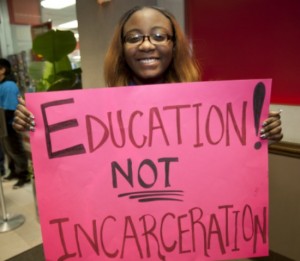
Nearly 70 percent of Michigan’s prisoners sentenced to juvenile life without parole are Black and Latino.
“In the meantime, the lives of many Black and Latin students have been changed forever over the last six years,” Washington noted. “These policies have already ruined enough lives. It is crucial that we train a new generation of leaders for the new majority-minority country.”
In the wake of the Sixth Circuit Court decision, BAMN is launching a statewide campaign, kicked off with a rally Dec. 7 at the U of M campus in Ann Arbor, to demand:
- The University of Michigan, Michigan State University, Wayne State University, and all of Michigan’s universities act immediately on the Sixth Circuit decision and reinstate their affirmative action policies in this admissions cycle, and
- Michigan’s universities create Dream Scholarships, offer full access to financial aid and in-state tuition to undocumented students.
They say they are aiming to double the enrollment of “under-represented minority” students in 2013-14. http://www.bamn.com/social-justice/reinstate-affirmative-action-in-michigan-now.
For more information, contact the law offices of Scheff, Washington & Driver at 313-963-1921, or go to the BAMN website at http://www.bamn.com/ .
Sign petition for immediate compliance with Sixth Circuit Court ruling at https://docs.google.com/a/ueaa.net/spreadsheet/viewform?formkey=dEt0dERzX2p3YjhCaDNGUTFIUHFfS1E6MQ

